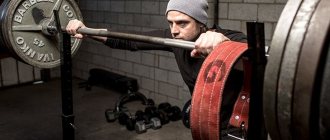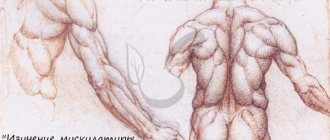Good afternoon, dear readers. Today we’ll talk about a process that every athlete is familiar with first-hand, because it can significantly slow down the achievement of results after training. Catabolism is a natural and important process for the body, but it is often what prevents the growth of muscle mass in the body. However, this can and should be fought. How? We'll talk about this below.
In response to this unfamiliar term, newcomers to the sport can often hear a logical question: “What is this?” Let's understand catabolism and anabolism - two most important components of the metabolic process and also two complete opposites of each other.
The term anabolism is understood as the totality of all processes in the body aimed at creating new cells and tissues in the body. Therefore, when after intense training you notice a natural increase in muscle mass, this is precisely his merit.
Catabolism, on the contrary, is aimed at destruction. This is the process of breaking down complex substances in the body into simple components, as a result of which the cells and tissues of the body disintegrate. Let's go over the basics. Let's start with metabolism.
SYMPTOMS OF THE DISEASE
Muscle tissue diseases are disorders of the working condition of an individual muscle or an entire group caused by various reasons and locations. As a rule, muscle tissue diseases have common symptoms.
- sharp or dull (aching) pain in the disease area (neck, shoulder girdle, lower back and others);
- increased pain when pressing, leaving a state of rest (when getting up in the morning), physical activity;
- redness and swelling of the skin in the area of the disease;
- detection of swelling or nodules in the muscles;
- muscle weakness, which is accompanied by dystrophy (shrinkage);
- pain and difficulty in performing simple everyday movements (turning the head, nodding, bending the body).
Basic Principles of Muscle Growth and Breakdown
►It is impossible to influence the normal process of muscle protein renewal, but you can try to avoid additional losses of muscle mass.
►As you understand, muscles do not simply break down beyond normal limits; this requires certain conditions, namely a stressful state. This could be fasting, lack of sleep, physical activity, nervous strain, or illness.
As soon as stress occurs, catabolic hormones are released such as cortisol, glucagon, adrenaline, etc. Their task is to provide the body with energy, even at the cost of destroying muscle tissue. It's better to eat a small part of yourself than to be completely eaten by your enemy!
Read also: Dysplasia in men, what is it?
►You can easily sleep a lot, eat well, and not be nervous, but you cannot avoid active training. Just during strength training, you can lose up to several hundred grams of muscle mass! Next, let's look at why this might happen.
►When you begin strength training, your body takes energy from muscle glycogen (carbohydrates). This is very convenient, because the fuel is in the muscles themselves. 100 g of muscle can hold up to 2 g of glycogen, and for professional athletes even up to 4 g.
If you multiply by the entire body weight, you get 1000-1500 g of glycogen and another 100-150 g in the liver. It turns out 4400-6600 calories. Why do you need to convert to calories? Read on!
►Weight training (bodybuilding) is far from the most energy-intensive form of physical activity. An athlete weighing 80 kg will spend about 500 calories in 1 hour. For comparison, while walking at a brisk pace (7 km/h) he would have to burn about 650 calories.
►Should we worry about where to get a measly 500 calories from if we only have 6,000 calories worth of glycogen? Really worth it!
►Glycogen is not stored in muscles as reliably as thigh fat. It is constantly being used up and replenished. If you feel hungry, consider that there is almost no “extra” glycogen. In this state, the body will very quickly begin to burn muscle for energy.
Glycogen is stored evenly in all muscles. If you pump your biceps, it uses up its own glycogen and will not be able to take reserves from your legs.
You can’t count on liver glycogen either, because it is intended primarily to nourish the brain.
►Another interesting point is that the body will not wait for the moment when you completely use up all the glycogen and fold your arms from a loss of strength. Shortly after starting a workout, cortisol levels rise, and it has a simple job - just in case, it destroys muscle.
►The less glycogen you have and the more intense the workout, the greater the cortisol release. Notice that after 60 minutes of training, cortisol begins to rise again.
►100 g of muscle contains about 20 g of protein (80 calories). Thus, if during training you do not have enough calories from glycogen, you will have to part with 20 g of muscle.
TYPES OF MUSCLE DISEASES
Muscle diseases are divided into groups that have a similar occurrence, characteristic manifestations, course and treatment methods.
Diseases include:
- myasthenia gravis – muscle weakness due to autoimmune processes;
- myalgia – pain in muscle tissue due to cell spasm;
- myositis - inflammatory processes that occur against the background of infections, parasites, and other causes);
- Rhabdomyolysis is a serious disease that develops due to the destruction of skeletal muscle and the release of myoglobin (protein) into the blood.
SYMPTOMS OF THE DISEASE
A disease of the autoimmune system that causes muscle weakness due to interruptions in neuromuscular transmission is called myasthenia gravis. The activity of the ocular, facial and masticatory muscles is usually impaired; the muscles of the respiratory organs are less commonly affected. Characteristic manifestations: drooping of the lower eyelid, disturbances in vocal function (nasal sound, hoarseness, hoarseness or weakness), disturbances in swallowing and chewing.
The word "myasthenia" means impotence, muscle weakness. This is a pathological process, which is based on the self-destruction of body cells. The normal immune response changes direction and begins to destroy its own cells instead of foreign ones, which leads to the destruction of organs and tissues of the body.
Possible reasons:
- genetic predisposition;
- benign or malignant tumors;
- systemic diseases;
- damage to the nervous system;
- hyperthyroidism, sleeping sickness.
When to see a doctor
Make an appointment with your doctor if you experience the following symptoms:
- muscle weakness that does not disappear;
- a red or purple rash on the face that doesn't go away or scaly plaques on the joints;
- muscle pain that does not go away after rest and standard painkillers;
- swelling in any muscle, especially if accompanied by a high fever or other symptoms;
- muscle pain and weakness that begins after taking new medications.
Read also: Can you drink while taking antibiotics?
Contact your doctor immediately if:
- you have a high temperature along with muscle pain and weakness;
- the muscle feels hot, painful and tense;
- your child complains of severe pain in his leg and has difficulty walking.
Article added to Yandex Webmaster 2015-06-25, 15:12
45 minutes after the start of training, a hormone that destroys muscles, cortisol, is produced. How to reduce the level of its production?
What is cortisol?
Cortisol is the main catabolic hormone. Increasing its level leads to the destruction of muscles into amino acids that can be absorbed by the body, and glycogen (the main nutrient for muscles) into glucose, again for quick energy production.
It is important that increased cortisol levels lead to increased accumulation of subcutaneous fat, increases appetite (due to increased blood glucose levels), and also causes an increase in blood pressure.
Exercise and cortisol levels
Cortisol is produced in response to stress, fatigue, exercise, fasting, fear and other emergency situations. For comparison: normal cortisol levels are 10 g/dL, with a cold – 40 g/dL, with stress – 80 g/dL, with severe shock – 180 g/dL.
If we talk about physical activity, then in the first minutes of exercise the natural level of cortisol rises to 63 g/dl, then it drops to 35 g/dl at about 45 minutes, and again begins to rise sharply (see graph*, top line).
How to lower cortisol levels?
It was found that if during the workout itself you consume 5-10 g of BCAAs (the three most important amino acids for us), mixed with 20-30 g of simple carbohydrates (calculation for a person weighing 75 kg), then the level of cortisol is significantly reduced (see. graph, bottom line).
This can easily be explained by the fact that the hormone cortisol is produced to urgently provide the body with energy, and if a person already receives important amino acids and glucose, then his body simply does not need to make excessive sacrifices.
Optimal training duration
As you can see from the graph, after 45 minutes of training (without supplements in the form of BCAAs and glucose), cortisol levels rise sharply - this means that after this time the body begins to eat its own muscles for energy.
Actually, this is where the recommendation comes from to exercise no more than 45-60 minutes. But the good news is that when you take a supplement, you lower your cortisol levels and your workout can be longer and more effective.
Why does BCAA help?
BCAAs are the three most important amino acids that cannot be synthesized in the body on their own (leucine, isoleucine, valine). Moreover, leucine is critical for muscle growth, and with its deficiency, muscles simply do not grow.
By taking BCAAs in the first half of your workout, you provide your muscles with a significant supply of leucine. And the above-mentioned 20-30 g of simple carbohydrates (you can use regular sugar) are important for the body for the rapid synthesis of energy.
During exercise, the stress hormone cortisol is produced, which destroys muscles. Maximum production occurs 45-60 minutes after the start of training. Using supplements can stop this process.
It is known from physiology textbooks that in the body of a healthy man who does not engage in sports, up to 100 g of proteins are renewed per day. Whether you train this way or not, muscles are still constantly breaking down and growing.
Naturally, these processes are more active in athletes. If you try to minimize muscle breakdown and create ideal conditions for their growth, you have a chance to get a beautiful athletic figure.
MYASTHENIAS
A disease of the autoimmune system that causes muscle weakness due to interruptions in neuromuscular transmission is called myasthenia gravis. The activity of the ocular, facial and masticatory muscles is usually impaired; the muscles of the respiratory organs are less commonly affected. Characteristic manifestations: drooping of the lower eyelid, disturbances in vocal function (nasal sound, hoarseness, hoarseness or weakness), disturbances in swallowing and chewing.
The word "myasthenia" means impotence, muscle weakness. This is a pathological process, which is based on the self-destruction of body cells. The normal immune response changes direction and begins to destroy its own cells instead of foreign ones, which leads to the destruction of organs and tissues of the body.
Possible reasons:
- genetic predisposition;
- benign or malignant tumors;
- systemic diseases;
- damage to the nervous system;
- hyperthyroidism, sleeping sickness.
Danger and consequences
The danger of myositis lies not only in the fact that the disease disrupts the patient’s quality of life, limiting his freedom of movement, but also threatens the development of more severe consequences.
Complications of myositis are:
- The spread of the disease to adjacent muscles with the involvement of vital organs in the pathological process.
- Muscle tissue atrophy. If the disease progresses and is not treated, then a complete loss of working capacity is possible with the emergence of the need for systematic care.
- Ossification of muscle fibers, which can ultimately even lead to the death of the patient.
- Breathing and swallowing disorders if the muscles of the larynx, esophagus, and pharynx are involved in the process of inflammation.
- Complications of cervical myositis can include extensive damage to the ENT organs, followed by shortness of breath and stress on the cardiovascular system.
- Purulent myositis often leads to abscesses and phlegmon, which is a threat to human life.
MYALGIA
Pathology of muscle tissue, accompanied by acute or dull spastic pain, both in a tense state and at rest, is called myalgia. Soreness can be of different origin and intensity, it can intensify and subside. It usually occurs due to an inflammatory process in the fibers.
Myalgia - symptoms and treatment
The disease can occur as a result of foreign factors, the effects of which the body itself cannot overcome:
1. External causes - high or low temperature, strong pressure on muscles, bacteria, fungi and viruses, ultraviolet radiation, exposure to heavy metal salts or acids.
2. Internal causes - complications of diseases of internal organs.
Myalgia is a disorder that affects not only older people, but also children. Only a doctor can diagnose and determine individual therapy. If you do not consult a specialist in a timely manner and the disease develops, then from an acute form it can become chronic (permanent).
Basic metabolic processes
Many people confuse metabolism with catabolism and metabolic rate. To understand the difference between the terms, you need to know what calories are and how they are measured. A calorie is nothing more than a unit of measurement of the energy “released” from food.
Most calories from fat. One gram of fat produces 9 calories, and one gram of protein or carbohydrates equals 4 calories.
Your body needs a lot of energy to support vital processes such as breathing, circulation, regulating body temperature, or kidney function. Approximately 60-75% of the total calories consumed in one day are consumed to maintain vital functions at optimal parameters.
Metabolism
A large number of reactions, under the action of enzymes, with the transformation of biological molecules.
Enzymes - catalysts for metabolism - are the most important elements in metabolism, as they reduce energy costs for chemical reactions.
Catabolism
During catabolism, sugar, fats, amino acids are broken down from elements, after this process simpler molecular compounds are formed. They become products of biosynthesis.
Anabolism
This is the biosynthesis of molecules with a complex structure. Includes three stages. In this process, the role of a catalyst is assigned to specialized elements. The result of biosynthesis is the appearance of lipids, nucleic acid, and amino acids.
MYOSITIS
Myositis is a group of diseases that manifest as inflammation in muscle tissue. Myositis is caused by various reasons, on which the prognosis of the disease depends. This problem is often encountered by people in professions that involve constantly being in one (often physiologically uncomfortable) position: drivers, musicians (violinists, pianists), athletes (tennis players), programmers, and so on.
Common reasons may be:
1. Infections of a viral or bacterial nature (flu).
2. Autoimmune diseases (rheumatoid arthritis, scleroderma, lupus erythematosus, etc.).
3. The influence of toxic substances (alcoholism, drug addiction).
4. Long-term use of certain medications.
Myositis - symptoms and treatment
The disease is manifested by the appearance of aching or dull pain in the affected tissues. It intensifies with movement or pressure. Muscle weakness is often noted. Redness and swelling of the skin are rare. The most common are cervical and lumbar myositis. They develop due to constant exposure to an uncomfortable position, due to hypothermia, or previous diseases. Often the pain radiates to other areas and intensifies with activity. Treatment is aimed at suppressing inflammation, maintaining a healthy lifestyle, and using dosed physical activity.
Negative sides
From the above, however, it does not at all follow that there are no negative aspects associated with this phenomenon for a bodybuilder. In the above definition, the main emphasis is on tissue breakdown, which means that muscle is indeed one of the targets for catabolism.
Any training (of course, if we are talking about effective training) will be a huge stress for the body, which stimulates the production of various hormones. For example, during intense physical activity, the level of testosterone increases, which directly affects the rate of glucose catabolism, as well as glucocorticoids, which are responsible for the breakdown of complex proteins and amino acids.
Rhabdomyolysis
With muscle injuries (more common in athletes), gradual destruction of tissue occurs, this condition is called rhabdomyolysis. This process ultimately ends with the death (necrosis) of cells and the release of toxins into the circulatory system. This disease can cause serious complications and lead to kidney failure. If qualified assistance is not provided, it can result in death.
Possible reasons:
1. Bodily injuries (injuries, beatings, accidents, accidents).
2. Stage 3 and 4 burns.
3. Long surgical operations (more than 8–10 hours).
4. Long-term compression of tissues with impaired blood supply.
5. Electric shocks.
The development can be provoked by: increased loads during training, epileptic seizures, severe muscle spasms, delirium tremens.
It is very difficult to recognize the disease; the manifestations are similar to the symptoms of many diseases; sometimes rhabdomyolysis occurs secretly. Often the correct diagnosis can only be made based on the results of a blood test. In an advanced form, the patient may fall into a coma and die.
How to protect muscles from destruction during training?
1. Load up on complex carbohydrates 1-2 hours before training and in previous meals. This way you will have maximum glycogen. 2. Reduce training time to 45-60 minutes. If this is not enough for you, add 1 more workout per week. 3. Before training, take a portion of BCAA according to the instructions on the package. 4. Use additional cortisol blocking supplements (eg HMB). 5. Drink sweet water during training. This point is very controversial. You are unlikely to be able to drink water in which 50 g of sugar (10 teaspoons) is dissolved. It is not a fact that the body will have time to deliver this sugar to the muscles during training. However, there will be some positive effect from simple carbohydrates, because taking sugar will cause the release of insulin, a powerful anti-catabolic hormone.
►Should you worry about muscle breakdown during training? You decide. But even 50g of muscle mass that can be preserved turns into 500g in 10 workouts, and into 5 kg in 1 year.
Friends, support our group on Facebook, share this post with your friends or click the “Like” button! and you will always be aware of the latest news from the “Duty Rocking Chair”!
For you, we collect the best workouts, recommendations for proper nutrition and, of course, humor from the world of beautiful, energetic and healthy people - like you and me!
Click “Like” and receive only the best posts on Facebook ↓
DIAGNOSTICS
Diagnosis of diseases can only be carried out by a doctor at a medical center. It begins with a detailed questioning of the patient: the nature of the pain, its intensity, location, and factors that intensify it are clarified. The doctor palpates (feels) the affected muscles, noting increased sensations, tightness, and the presence of swelling. Then it is assigned:
- collection of blood tests (general and biochemistry), urine;
- electromyogram, ultrasound, CT, radiography, MRI;
- If necessary, the doctor may prescribe an ECG and muscle tissue biopsy.
Contacting a qualified specialist will help protect yourself from making an incorrect diagnosis, since the pain that appears can be indistinguishable from other diseases. For example, pain in the lumbar region with myositis may be indistinguishable from kidney disease or similar to a vertebral hernia or osteochondrosis. An advanced disease will be very difficult to cure.
TREATMENT
Treatment depends on the cause of the pathology. Non-steroidal drugs (local, tablet or injectable) are often prescribed, which eliminate inflammatory processes and anesthetize tissues.
For infectious diseases, antiviral, antiparasitic or antibacterial drugs are used. In the autoimmune form, drugs that suppress the immune system (glucocorticosteroids or cytostatics) are used. To strengthen the defenses, complexes of vitamins and minerals are prescribed.
Non-drug therapy plays a special role in treatment. This includes:
- massage (there are contraindications);
- physiotherapy;
- physiotherapy (electrophoresis, magnetotherapy, amplipulse therapy).
PREVENTION OF MUSCLE DISEASES
Preventive measures include a number of simple rules:
- avoid hypothermia, wear seasonal clothing;
- carefully follow all doctor’s orders for any disease;
- do not self-medicate;
- practice a healthy lifestyle;
- use regular exercise.
It is best to practice under the guidance of experienced instructors who will select an individual rehabilitation program and help you achieve a quick and high-quality recovery. This is the approach that the specialists at the Center for Restorative Medicine follow. The cost of admission and other details can be found on the Center’s website or by calling.
Bottom line
Myositis is a disease that affects one of the most important tissues in the body - muscle. The large number of species makes it difficult to diagnose, however, laboratory and instrumental examination methods make it possible to determine the specific type of myositis in the early stages of the disease.
Treatment should be selected individually for each patient, depending on the form, severity of symptoms and course of the disease. It is aimed not only at reducing symptoms, but also at eliminating the cause. If doctors manage to complete both stages of therapy in full, the patient will be able to forget about myositis forever.
Unfortunately, some forms of the disease cannot be completely cured, but even with them it is possible to maintain a decent quality of life for the patient.











